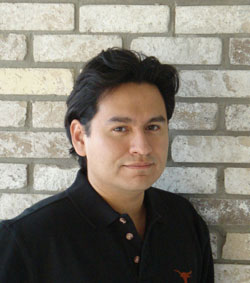Dr. David Campos: Combating Childhood Obesity
by Rebecca Esparza
Five years ago, San Antonio native Dr. David Campos was startled by what
he observed in local restaurants. He had been on a Fulbright Scholarship
traveling to China and had recently returned home from teaching at Roosevelt
University in Chicago. Now an associate professor of education with UIW’s
Dreeben School of Education, Campos saw his hometown in an  entirely different
light.
entirely different
light.
“I'll never forget that within a few weeks, I noticed an alarming amount of obese schoolchildren in public places,” he recalled. “There was this obese 4-year-old girl in a Tex-Mex restaurant whose mother ordered her an adult-sized plate. Minutes later, I observed her eating tamales wrapped in flour tortillas while drinking a Big Red soda. I wondered immediately: What is to become of this child in a few years?”
Shortly after that, he visited a local salad bar and noticed an overweight young boy eating. “I was impressed his mother was taking steps to expose her obese child to some healthy eating. That was until I saw what he was eating for dinner: nacho cheese dip, along with about a dozen breadsticks.”
He recognized a significant increase in the number of obese children in San Antonio compared with the early 1990s and so began his crusade to investigate the complexity of the situation. After doing research, Campos learned the number of Mexican-American boys in the United States who are clinically obese is higher than any other ethnic race.
“I realized immediately there was work to be done in this area, bringing awareness of the childhood obesity epidemic to our educators and those working with our children everyday,” he said.
Last year, Campos published a book on the subject, Expanding Waistlines: An Educator's Guide to Childhood Obesity (Sense Publishers, 2007). He noted the book is meant to “give classroom teachers an idea of the current state of affairs.”
The problem, Campos cited in his book, goes beyond just weight. He noted obesity is often the conduit for a host of other medical problems, including heart disease, diabetes, mental health issues and other lifelong ailments.
According to the U.S. government, the number of obese children has tripled since 1980. Luckily, there are multiple government programs recently instituted that are meant to encourage ways to combat childhood obesity. Ironically, it was a piece of government legislation that helped turn the obesity problem into a nationwide epidemic.
“The No Child Left Behind Act left school districts with no choice but to abandon recess to make room for more instruction time,” Campos said. “Thankfully, now we are seeing school districts starting to enforce physical education again.”
The book also provides an overview of up-to-date demographics, including data citing the percentage of obese adults versus youth for each state. Texas ranks among the highest in the nation for percentage of obese adults, at 25.5 percent, and in the top 10 for obese youth (ages 10-17), at 32 percent.
Campos understands the conundrum that exists for low-income families trying to eat a healthy, well-balanced diet. He cited an example of a family of four with only $5 to spend on a meal. “It would be easy to go to the grocery store and purchase a loaf of bread and some hot dogs. Conversely, just the other day I spent almost $5 on just four peaches. Eating well definitely is not cheap.”
But he said there are inexpensive ways a family can combat the problem. “Parents can work on portion control and encourage more physical activity,” he suggested. But parents still must beware of eating on-the-go or separately too often and how much time their children spend playing video games.
Ultimately, it's about helping children make healthy food choices, not enforcing a strict diet, Campos added.
“I'm not a proponent of diets because they are too restrictive. The idea is to help children learn how to eat healthy foods and control their portions accordingly. Children also respond well to fun outdoor activities. The key is to make physical activity not seem like work.”
